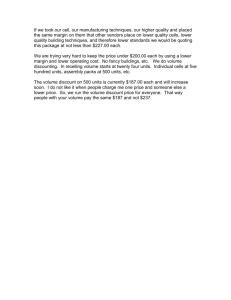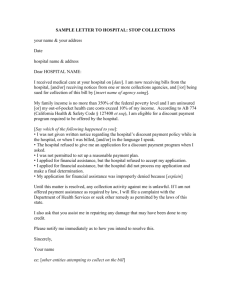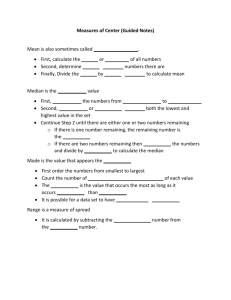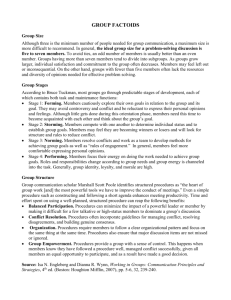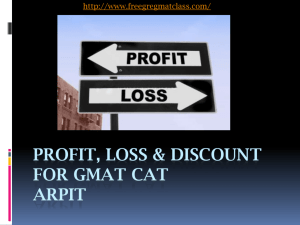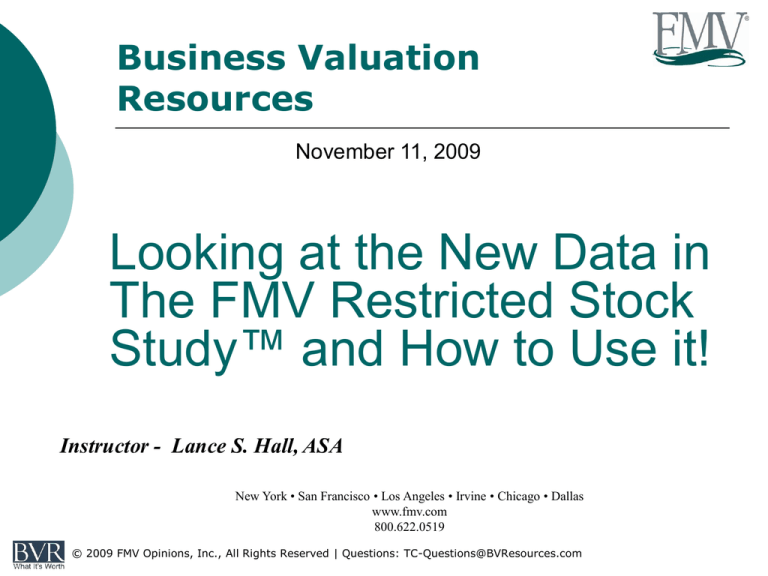
Business Valuation
Resources
November 11, 2009
Looking at the New Data in
The FMV Restricted Stock
Study™ and How to Use it!
Instructor - Lance S. Hall, ASA
New York • San Francisco • Los Angeles • Irvine • Chicago • Dallas
www.fmv.com
800.622.0519
© 2009 FMV Opinions, Inc., All Rights Reserved | Questions: TC-Questions@BVResources.com
The FMV Restricted Stock Study™ New Developments
Recently added more than 120 new
transactions
VIX variable available for each
transaction between July 1990 and
December 2008
More detailed information regarding
registration of shares
Coming Soon:
Over 40 new transactions subject to 6-month
Rule 144 initial holding period
Updated Companion Guide freely available at
bvresources.com
© 2009 FMV Opinions, Inc., All Rights Reserved | Questions: TC-Questions@BVResources.com
1
Today’s
Outline
•
•
•
•
•
•
Discounts Over 50% are O.K.
Theoretical Foundation
What is Restricted Stock?
The FMV Restricted Stock Study™
How to Use the FMV Study
Case Study
© 2009 FMV Opinions, Inc., All Rights Reserved | Questions: TC-Questions@BVResources.com
2
Discounts
Over
50% are O.K.
© 2009 FMV Opinions, Inc., All Rights Reserved | Questions: TC-Questions@BVResources.com
3
Discounts Over
50% are O.K.
During times of extreme
volatility in the stock or
in the market, discounts
for lack of marketability
will often exceed 50
percent.
© 2009 FMV Opinions, Inc., All Rights Reserved | Questions: TC-Questions@BVResources.com
4
Discounts Over
50% are O.K.
2008 the Dow Plummets
Dow Jones Industrial Average
14000
13000
12000
11000
10000
9000
8000
08
0
2
2/
1/
08
0
2
1/
2/
08
0
2
2/
3/
08
0
2
1/
4/
08
08
08
08
08
08
0
0
0
0
0
0
2
/2
/2
/2
/2
/2
1/
31
30
30
29
28
5/
/
/
/
/
/
5
6
7
8
9
© 2009 FMV Opinions, Inc., All Rights Reserved | Questions: TC-Questions@BVResources.com
5
Discounts Over
50% are O.K.
Investors Seek Safety and
Liquidity in Short-Term Treasuries
3-Month Treasury Yields
3.5
3
2.5
2
1.5
1
0.5
0
1/ 2/ 08
2/ 1/ 08
3/ 2/ 08
4/ 1/ 08
5/ 1/ 08
5/ 31/ 08
6/ 30/ 08
7/ 30/ 08
© 2009 FMV Opinions, Inc., All Rights Reserved | Questions: TC-Questions@BVResources.com
8/ 29/ 08
9/ 28/ 08
6
Discounts Over
50% are O.K.
The FMV Restricted Stock Study™
Analyzing Volatility
1980 – 2008
Top Decile
Top Quintile
Second Quintile
Third Quintile
Fourth Quintile
Bottom Quintile
Bottom Decile
High
2,024.7%
2,024.7%
110.2%
82.0%
71.1%
54.0%
41.9%
Volatility
Low
144.8%
110.8%
82.4%
71.2%
54.0%
2.8%
2.8%
Average
285.4%
204.7%
97.6%
76.3%
61.7%
39.5%
30.3%
High
91.3%
91.3%
59.0%
64.2%
56.6%
84.3%
43.3%
Discount
Low
Average Median
0.0%
44.3% 45.7%
0.0%
39.4% 36.3%
1.9%
25.8% 23.8%
0.0%
19.9% 16.3%
0.0%
19.0% 17.6%
0.0%
15.8% 12.9%
0.0%
11.8%
9.4%
© 2009 FMV Opinions, Inc., All Rights Reserved | Questions: TC-Questions@BVResources.com
7
Discounts Over
50% are O.K.
Chicago Board Options Exchange’s
Volatility Index
VIX "is a good indicator of the level of
fear or greed in U.S. and global capital
markets. When investors are fearful, the
VIX level is significantly higher than
normal.”[1]
[1]
Antognelli, Ferreira, McArdle, and Traub, "Fear and Greed in Global Asset Allocation" The Journal of Investing (Spring 2000), pp. 27—32.
© 2009 FMV Opinions, Inc., All Rights Reserved | Questions: TC-Questions@BVResources.com
8
Discounts Over
50% are O.K.
Chicago Board Options Exchange’s
Volatility Index
“VIX values greater than 30 are generally
associated with a large amount of volatility
as a result of investor fear or uncertainty,
while values below 20 generally correspond
to less stressful, even complacent, times in
the markets.”
[2]
[2]
Investopedia, a Forbes digital company.
© 2009 FMV Opinions, Inc., All Rights Reserved | Questions: TC-Questions@BVResources.com
9
1/
2/
1
7/ 99
2/ 0
1
1/ 99
2/ 0
1
7/ 99
2/ 1
1
1/ 99
2/ 1
1
7/ 99
2/ 2
1
1/ 99
2/ 2
1
7/ 99
2/ 3
1
1/ 99
2/ 3
1
7/ 99
2/ 4
1
1/ 99
2/ 4
1
7/ 99
2/ 5
1
1/ 99
2/ 5
1
7/ 99
2/ 6
1
1/ 99
2/ 6
1
7/ 99
2/ 7
1
1/ 99
2/ 7
1
7/ 99
2/ 8
1
1/ 99
2/ 8
1
7/ 99
2/ 9
1
1/ 99
2/ 9
2
7/ 00
2/ 0
2
1/ 00
2/ 0
2
7/ 00
2/ 1
2
1/ 00
2/ 1
2
7/ 00
2/ 2
2
1/ 00
2/ 2
2
7/ 00
2/ 3
2
1/ 00
2/ 3
2
7/ 00
2/ 4
2
1/ 00
2/ 4
2
7/ 00
2/ 5
2
1/ 00
2/ 5
2
7/ 00
2/ 6
2
1/ 00
2/ 6
2
7/ 00
2/ 7
2
1/ 00
2/ 7
2
7/ 00
2/ 8
2
1/ 00
2/ 8
20
09
Discounts Over
50% are O.K.
VIX
90
80
70
60
50
40
30
20
10
0
© 2009 FMV Opinions, Inc., All Rights Reserved | Questions: TC-Questions@BVResources.com
10
Discounts Over
50% are O.K.
2008 Fall VIX Readings
90
80
70
60
50
40
30
20
10
© 2009 FMV Opinions, Inc., All Rights Reserved | Questions: TC-Questions@BVResources.com
00
8
12
/8
/2
00
8
12
/1
/2
08
11
/2
4/
20
08
20
7/
/1
11
11
/1
0/
20
08
00
8
11
/3
/2
08
10
/2
7/
20
08
20
0/
/2
10
10
/1
3/
20
08
00
8
10
/6
/2
00
8
9/
29
/2
00
8
/2
22
9/
9/
15
/2
00
8
08
20
8/
9/
08
20
1/
9/
00
8
/2
25
8/
8/
18
/2
00
8
0
11
Discounts Over
50% are O.K.
© 2009 FMV Opinions, Inc., All Rights Reserved | Questions: TC-Questions@BVResources.com
12
Discounts Over
50% are O.K.
2008-2009 VIX Readings
90
80
70
60
50
40
30
20
10
© 2009 FMV Opinions, Inc., All Rights Reserved | Questions: TC-Questions@BVResources.com
3/
27
/2
00
9
3/
13
/2
00
9
2/
13
/2
00
9
2/
27
/2
00
9
1/
30
/2
00
9
1/
16
/2
00
9
1/
2/
20
09
12
/1
9/
20
08
12
/5
/2
00
8
11
/7
/2
00
8
11
/2
1/
20
08
10
/2
4/
20
08
10
/1
0/
20
08
9/
12
/2
00
8
9/
26
/2
00
8
8/
29
/2
00
8
0
13
Discounts Over
50% are O.K.
Market Volatility Analysis1
VIX 6-Month
Average
Median
VIX
Percent
Shares
Placed
Market
Value
MTB
Ratio
Median
Trans.
Discount
Multiplicative
Adj. Factor
From Middle
Quintile
Low
High
Top Decile
Top Quintile
Second Quintile
28.53 25.75 23.33 -
32.87
32.87
25.74
29.6
28.5
24.3
6.9%
8.1%
7.2%
27.8
27.7
39.2
2.9
2.8
3.5
32.1%
26.9%
25.0%
42.7%
19.6%
11.1%
Middle Quintile
17.52 -
23.33
22.2
9.6%
39.5
3.5
22.5%
0.0%
(1) Excludes transactions with "% Shares Placed" > 20% and "Market Value" > $100 million. Transaction set
includes 234 transactions between 1990 and December 31, 2008.
© 2009 FMV Opinions, Inc., All Rights Reserved | Questions: TC-Questions@BVResources.com
14
Discounts Over
50% are O.K.
From September 19th through
December 29th, 2008, the VIX
Averaged 56.6.
If the VIX is 56.6, the Discount for
Lack of Marketability Should be 17
to 37 Percentage Points Higher than
During Normal Times!
© 2009 FMV Opinions, Inc., All Rights Reserved | Questions: TC-Questions@BVResources.com
15
Discounts Over
50% are O.K.
From January 2nd through April
6th, 2009, the VIX Averaged
44.8.
If the VIX is 44.8, the Discount
for Lack of Marketability Should
be 11 to 27 Percentage Points
Higher than During Normal
Times!
© 2009 FMV Opinions, Inc., All Rights Reserved | Questions: TC-Questions@BVResources.com
16
Discounts Over
50% are O.K.
Further Evidence: Western
Alliance Bancorporation
June 27, 2008 Private Placement:
Block
Size – 11.2%
Registration Rights (45 days)
Public Price – $8.11 per share
© 2009 FMV Opinions, Inc., All Rights Reserved | Questions: TC-Questions@BVResources.com
17
Discounts Over
50% are O.K.
Further Evidence: Western
Alliance Bancorporation (cont.)
September 30, 2008 Private
Placement:
Block
Size – 11.3%
Registration Rights (30 days)
Public Price – $15.46 per share
© 2009 FMV Opinions, Inc., All Rights Reserved | Questions: TC-Questions@BVResources.com
18
Discounts Over
50% are O.K.
Further Evidence: Western
Alliance Bancorporation (cont.)
Market Conditions
June 27
B of A $23.51
Wells $23.06
WAL
$8.11
Sept. 30
$34.13
$36.41
$15.46
%Δ
^45.2%
^57.9%
^90.6%
© 2009 FMV Opinions, Inc., All Rights Reserved | Questions: TC-Questions@BVResources.com
19
Discounts Over
50% are O.K.
Further Evidence: Western
Alliance Bancorporation (cont.)
Which Transaction Date has the
Higher Discount?
© 2009 FMV Opinions, Inc., All Rights Reserved | Questions: TC-Questions@BVResources.com
20
Discounts Over
50% are O.K.
Further Evidence: Western
Alliance Bancorporation (cont.)
June 27, 2008 Private Placement:
Discount
= 2.1%
September 30, 2008 Private
Placement:
Discount
= 25.6%
© 2009 FMV Opinions, Inc., All Rights Reserved | Questions: TC-Questions@BVResources.com
21
Discounts Over
50% are O.K.
Further Evidence: Western
Alliance Bancorporation
WHY?
June 27, 2008 Private Placement:
VIX
= 24.0
September 30, 2008 Private Placement:
VIX
= 39.4
© 2009 FMV Opinions, Inc., All Rights Reserved | Questions: TC-Questions@BVResources.com
22
Discounts Over
50% are O.K.
Further Evidence: Western
Alliance Bancorporation (cont.)
Historic Volatility
2
Years
Year
6
Months
3
Months
1
Month
2
Weeks
As of June 27, 2008
49%
64%
68%
56%
50%
52%
As of September 30, 2008
82%
109%
137%
182%
226%
333%
% Change
66%
70%
101%
223%
348%
544%
1
© 2009 FMV Opinions, Inc., All Rights Reserved | Questions: TC-Questions@BVResources.com
23
Discounts Over
50% are O.K.
2008 Private Placements - Common Stock and Common Stock
With Warrants
Transaction Discounts and VIX
45
40
35
Transaction Discount (%)
Average VIX
30
25
20
15
10
5
0
1st Half 2008 (N=72)
2nd Half 2008 (N=46)
© 2009 FMV Opinions, Inc., All Rights Reserved | Questions: TC-Questions@BVResources.com
24
Discounts Over
50% are O.K.
What Does 2008 Tell Us?
When the VIX increased by 79%,
the Discount increased by 65%!
If your Discount in the first half of
2008 was 30%, then your second
half discount should be 49.5%!
© 2009 FMV Opinions, Inc., All Rights Reserved | Questions: TC-Questions@BVResources.com
25
Theoretical
Foundation
© 2009 FMV Opinions, Inc., All Rights Reserved | Questions: TC-Questions@BVResources.com
26
Theoretical Foundation
Marketability – What is
Legally Permissible
Liquidity – What is
Practical and Achievable
© 2009 FMV Opinions, Inc., All Rights Reserved | Questions: TC-Questions@BVResources.com
27
Theoretical Foundation
Investment Performance: Changes in a
Way to Influence You to Sell (Actual &
Relative)
Personal Needs: Changes in Personal
Cash Needs
Exit Strategy: Changes in Anticipated Exit
Means
© 2009 FMV Opinions, Inc., All Rights Reserved | Questions: TC-Questions@BVResources.com
28
What is
Restricted Stock?
© 2009 FMV Opinions, Inc., All Rights Reserved | Questions: TC-Questions@BVResources.com
29
What is Restricted Stock?
Restricted Stock
Comparisons
Arm’s-Length Transactions
But for Restrictions Identical Securities
Restrictions Solely Affect Marketability
Contemporaneous Transactions
© 2009 FMV Opinions, Inc., All Rights Reserved | Questions: TC-Questions@BVResources.com
30
What is Restricted Stock?
Restricted Stock Comparisons
Temple v. U.S., No. 9:03-CV-165
(March 10, 2006)
“The better method is to analyze the data
from the restricted stock studies and
relate it to the gifted interests in some
manner, as [the IRS’s expert] did.”
© 2009 FMV Opinions, Inc., All Rights Reserved | Questions: TC-Questions@BVResources.com
31
What is Restricted Stock?
Securities Act of 1933;
Reg. §230.144
Definitions: “affiliate” “person” “restricted”;
Not an underwriter;
Holding period;
Volume limits;
Manner of sale;
Broker’s transactions;
Notice of intention to sell; and
Termination of restrictions for non-affiliates.
© 2009 FMV Opinions, Inc., All Rights Reserved | Questions: TC-Questions@BVResources.com
32
What is Restricted Stock?
Securities and Exchange Act of 1934
1934 Act, Section 16
a. Disclosures required
b.
c.
d.
Applies to 10% owners, directors, or
officers
Short-swing profit recovery
No short selling
Exemptions
Often, companies will institute “blackout” periods to ensure compliance with
Section 16
© 2009 FMV Opinions, Inc., All Rights Reserved | Questions: TC-Questions@BVResources.com
33
What is Restricted Stock?
1972 SEC Adopts Rule 144
Two-Year Holding Period
Dribble-Out Provisions:
Every Quarter, Greater of:
One percent of total shares
outstanding, or
Average weekly trading volume over
prior four weeks
© 2009 FMV Opinions, Inc., All Rights Reserved | Questions: TC-Questions@BVResources.com
34
What is Restricted Stock?
Restrictions Applicable to
Unregistered Stock
Affiliate Stock (Dribble-Out
Provisions)
Insider
Over 10 Percent Ownership
1983 Rule 144(k)
Non-Affiliate, 3-Year Maximum
Restriction
© 2009 FMV Opinions, Inc., All Rights Reserved | Questions: TC-Questions@BVResources.com
35
What is Restricted Stock?
1990 Tacking
1997 Amendment
No “Restart” 1983 Rule 144(k)
One-Year Holding Period
Non-Affiliate, Two-Year
Maximum Restriction
2007 Amendment
Six-Month Holding Period
© 2009 FMV Opinions, Inc., All Rights Reserved | Questions: TC-Questions@BVResources.com
36
Revenue Ruling 77-287
Risk of value change that “would
have” prompted decision to sell
Risk that means of disposal may not
materialize
Four rules for determining discount:
No formulas;
Function of earnings, assets, sales;
Function of trading market; and
Function of resale constraints
© 2009 FMV Opinions, Inc., All Rights Reserved | Questions: TC-Questions@BVResources.com
37
Traditional Restricted Stock
Studies
Restricted Stock Study
Years
Average
1966-1969
25.8%
Gelman
1968-70
33.0%
Trout
1968-72
33.5%
Not Specified
35.6%
Maher
1969-73
35.4%
Standard Research Consultants
1978-82
45.0%
Willamette Management Assoc.
1981-84
31.2%
Silber
1981-88
33.8%
Management Planning
1980-96
27.1%
Institutional Investor Study
Moroney
* Source: Pratt, Reilly, and Schweihs: Valuing a Business, 4th Ed., 2000
© 2009 FMV Opinions, Inc., All Rights Reserved | Questions: TC-Questions@BVResources.com
38
THE FMV
RESTRICTED
™*
STOCK STUDY
* Available Through BVR at bvresources.com
© 2009 FMV Opinions, Inc., All Rights Reserved | Questions: TC-Questions@BVResources.com
39
The FMV Restricted Stock Study™
597 Transactions from 1980
through 2008
50+ Data Fields per Transaction
All Arm’s-Length Transactions
Pure Play – No Warrants, Units, or
“Sweeteners”
The Largest Restricted Stock
Study Available Anywhere
© 2009 FMV Opinions, Inc., All Rights Reserved | Questions: TC-Questions@BVResources.com
40
The FMV Restricted Stock Study™ New Developments
Recently added more than 120 new
transactions
VIX variable available for each
transaction between July 1990 and
December 2008
Over 40 new transactions subject to 6month Rule 144 initial holding period
More detailed information regarding
registration of shares
Updated Companion Guide freely
available at bvresources.com
© 2009 FMV Opinions, Inc., All Rights Reserved | Questions: TC-Questions@BVResources.com
41
The FMV Restricted Stock
Study™ — Histogram
100
90
80
70
60
50
40
30
20
10
0
<
-1
0% 10%
to
-5 -5%
%
to
0% 0 %
t
5% o 5
%
t
10 o 1
% 0%
t
15 o 1
% 5%
t
20 o 2
% 0%
t
25 o 2
% 5%
t
30 o 3
% 0%
35 to 3
% 5%
t
40 o 4
% 0%
t
45 o 4
% 5%
t
50 o 5
% 0%
t
55 o 5
% 5%
t
60 o 6
% 0%
65 to 6
% 5%
t
70 o 7
% 0%
75 to
% 75
to %
10
0%
Frequency
Histogram: The FMV Restricted Stock Study (1980-2008)
Restricted Stock Discount
© 2009 FMV Opinions, Inc., All Rights Reserved | Questions: TC-Questions@BVResources.com
42
Dispersion of Data by Discount
Quintile
1980 – 2008 (All Transactions, 597 Count*)
Quintile
1
Discount
1.6%
10.5%
16.7%
27.3%
43.7%
166,358
162,682
110,814
68,824
44,309
66,025
65,752
39,844
18,245
9,434
37,988
30,916
22,669
8,443
4,978
23,335
29,136
28,811
14,118
7,764
7.9%
9.9%
10.1%
9.4%
12.4%
3.5
3.9
3.7
5.8
6.0
68.3%
67.5%
71.8%
80.2%
104.2%
$12.49
$11.07
$12.02
$8.15
$8.17
Market Value ($)
Total Assets ($)
Book Value ($)
Revenues ($)
Percentage Block Size
MTB Ratio
Volatility
Price Per Share
2
3
4
5
* All company financial characteristics throughout this presentation have been inflationadjusted to 2009 dollars. Financial information provided at bvresources.com is not
adjusted for inflation.
© 2009 FMV Opinions, Inc., All Rights Reserved | Questions: TC-Questions@BVResources.com
43
Dispersion of Data by Discount
Quintile
1980 – 2008 (No Premiums or Registration Rights, 372 Count*)
Quintile
Discount
Market Value ($)
Volatility
MTB Ratio
Totals Assets ($)
Book Value ($)
Revenues ($)
Percentage Block Size
Price Per Share
1
2
4.8%
12.2%
166,133 152,422
71.0%
68.8%
3.24
4.70
68,014 50,368
41,941 30,381
18,011 18,461
8.0%
9.3%
$12.45 $13.04
3
4
5
20.1%
86,672
70.8%
4.52
28,521
14,992
17,190
9.5%
$10.23
31.2%
68,603
84.5%
7.95
13,083
6,460
6,818
5.8%
$7.88
47.7%
39,343
109.5%
6.62
8,649
4,246
4,720
14.2%
$8.36
* From this point forward, all tables and graphs are derived from the above data set, which
excludes all private placement transactions where premiums were paid for restricted
shares or which included registration rights.
© 2009 FMV Opinions, Inc., All Rights Reserved | Questions: TC-Questions@BVResources.com
44
Dispersion of Data by Discount
Quintile
1980 – February 1997 (Two-Year Holding Period)
Quintile
Discount
Market Value ($)
Volatility
MTB Ratio
Total Assets ($)
Book Value ($)
Revenues ($)
Percentage Block Size
Price per Share
1
2
3
4
5
4.8%
162,682
56.5%
4.02
72,452
39,751
28,237
11.3%
$14.63
13.0%
99,531
58.4%
3.99
36,480
22,069
35,927
9.0%
$15.23
21.0%
86,468
69.2%
4.57
22,129
14,386
16,698
10.4%
$10.51
31.2%
69,045
77.4%
6.79
17,180
7,262
17,364
8.3%
$9.90
43.2%
35,532
96.0%
7.92
8,684
5,233
7,576
15.4%
$9.87
© 2009 FMV Opinions, Inc., All Rights Reserved | Questions: TC-Questions@BVResources.com
45
Dispersion of Data by Discount
Quintile
March 1997 - 2001 (One-Year Holding Period)
Quintile
Discount
Market Value ($)
Volatility
MTB Ratio
Total Assets ($)
Book Value ($)
Revenues ($)
Percentage Block Size
Price per Share
1
2
3
4
5
6.0%
176,862
82.0%
2.59
61,136
46,080
9,137
6.6%
$9.67
17.6%
70,784
80.8%
6.71
23,686
9,763
8,329
8.8%
$6.95
27.8%
61,450
106.3%
9.31
9,674
7,566
2,152
5.2%
$6.58
42.5%
42,709
121.0%
4.39
10,103
4,724
3,995
7.6%
$7.76
63.2%
44,066
151.2%
2.09
4,871
978
1,818
16.4%
$8.19
© 2009 FMV Opinions, Inc., All Rights Reserved | Questions: TC-Questions@BVResources.com
46
Dispersion of Data by Discount
Quintile
2002 – November 15, 2007 (One-Year Holding Period)
Quintile
Discount
Market Value ($)
Volatility
MTB Ratio
Total Assets ($)
Book Value ($)
Revenues ($)
Percentage Block Size
Price per Share
1
2
3
4
5
4.8%
210,361
67.1%
3.10
111,207
42,085
11,479
6.6%
$6.16
9.4%
191,136
65.9%
4.94
50,533
31,752
8,336
11.5%
$8.67
13.5%
233,072
75.1%
2.99
52,253
40,279
11,033
10.1%
$9.31
20.8%
134,754
66.9%
4.18
36,976
12,805
17,693
7.4%
$11.25
33.8%
56,162
86.6%
7.27
9,510
5,014
6,564
5.7%
$4.15
© 2009 FMV Opinions, Inc., All Rights Reserved | Questions: TC-Questions@BVResources.com
47
Dispersion of Data by Discount
Quintile
March 1997 - 2001 (One-Year Holding Period)
Quintile
Discount
Market Value ($)
Volatility
MTB Ratio
Total Assets ($)
Book Value ($)
Revenues ($)
Percentage Block Size
Price per Share
1
2
3
4
5
5.0%
169,010
74.6%
2.99
61,498
42,085
11,479
6.6%
$6.62
11.7%
191,136
74.3%
4.74
53,009
39,175
9,137
9.5%
$8.67
20.5%
110,814
73.7%
3.75
51,497
22,532
12,174
7.5%
$10.28
31.9%
61,450
108.6%
7.95
9,100
6,286
2,466
3.6%
$6.58
58.5%
43,845
136.8%
3.14
5,065
3,231
2,192
12.8%
$7.31
© 2009 FMV Opinions, Inc., All Rights Reserved | Questions: TC-Questions@BVResources.com
48
Dispersion of Data by Year
Time Period
2008
2006-07
2004-05
2002-03
2000-01
1998-99
1996-97
1994-95
1992-93
1990-91
1988-89
1986-87
1984-85
1982-83
1980-81
Pre - March 1, 1997
March 1, 1997 - Nov. 15, 2007
Post - Nov. 16, 2007
No. of
Transactions
Market Value
Book Value
Volatility
Median
Discount
9
9
38
33
32
53
25
45
49
21
9
20
15
10
4
62,605
809,794
167,460
138,712
103,117
48,786
47,969
90,865
76,307
107,489
131,239
40,297
84,931
124,535
70,772
21,121
56,990
30,916
20,380
4,724
8,161
9,733
12,113
5,070
12,599
2,668
7,195
24,115
19,404
17,557
72.7%
68.5%
64.7%
75.8%
117.0%
106.3%
67.0%
77.5%
67.0%
63.0%
86.0%
73.0%
54.3%
77.5%
66.0%
16.7%
9.1%
12.0%
16.5%
30.4%
27.9%
17.8%
21.0%
24.8%
14.5%
15.8%
21.8%
23.8%
20.7%
31.0%
196
165
11
82,441
95,642
62,605
10,082
12,196
21,121
71.2%
86.4%
72.7%
21.0%
20.5%
15.0%
© 2009 FMV Opinions, Inc., All Rights Reserved | Questions: TC-Questions@BVResources.com
49
Dispersion of Data by SIC Code
1980 – 2008
SIC RANGE
No. of Transactions
Median Market Value
Median Revenues
Median MTB Ratio
Median Volatility
Average Discount
Median Discount
1000s
2000s
3000s
4000s
5000s
6000s
7000s
8000s
41
97,076
13,877
3.1
72%
20%
15%
45
150,849
7,008
5.0
73%
22%
16%
103
70,335
10,475
5.1
78%
25%
22%
25
146,896
23,543
8.9
85%
22%
18%
16
55,844
47,970
4.3
59%
13%
13%
40
112,384
52,931
1.7
47%
21%
16%
67
50,446
4,909
6.3
111%
31%
28%
35
104,461
13,329
6.1
73%
25%
25%
© 2009 FMV Opinions, Inc., All Rights Reserved | Questions: TC-Questions@BVResources.com
50
Dispersion of Data by Volatility
1980 – 2008
Top Decile
Top Quintile
Second Quintile
Third Quintile
Fourth Quintile
Bottom Quintile
Bottom Decile
High
2,024.7%
2,024.7%
110.2%
82.0%
71.1%
54.0%
41.9%
Volatility
Low
144.8%
110.8%
82.4%
71.2%
54.0%
2.8%
2.8%
Average
285.4%
204.7%
97.6%
76.3%
61.7%
39.5%
30.3%
High
91.3%
91.3%
59.0%
64.2%
56.6%
84.3%
43.3%
Discount
Low
Average Median
0.0%
44.3% 45.7%
0.0%
39.4% 36.3%
1.9%
25.8% 23.8%
0.0%
19.9% 16.3%
0.0%
19.0% 17.6%
0.0%
15.8% 12.9%
0.0%
11.8%
9.4%
© 2009 FMV Opinions, Inc., All Rights Reserved | Questions: TC-Questions@BVResources.com
51
Dispersion of Data by Volatility
March 1997 – November 15, 2007 (One-Year Holding Period)
Top Decile
Top Quintile
Second Quintile
Third Quintile
Fourth Quintile
Bottom Quintile
Bottom Decile
High
2,024.7%
2,024.7%
134.0%
104.8%
77.1%
60.1%
44.2%
Volatility
Low
162.1%
135.4%
105.0%
77.4%
62.1%
2.8%
2.8%
Average
398.6%
268.6%
116.0%
88.2%
70.9%
43.8%
31.6%
High
91.3%
91.3%
72.4%
64.2%
49.7%
84.3%
84.3%
Discount
Low
Average Median
0.0%
51.4% 54.5%
0.0%
42.9% 39.2%
0.0%
30.5% 27.9%
4.8%
21.2% 17.6%
0.0%
15.9% 12.5%
1.7%
18.8% 15.3%
1.7%
18.1% 11.7%
© 2009 FMV Opinions, Inc., All Rights Reserved | Questions: TC-Questions@BVResources.com
52
Dispersion of Data by Market
Value with Volatility
Market Value: 1980-2008
40%
110%
Median Discount
Median Volatility
100%
Median Discount
30%
90%
25%
80%
20%
70%
15%
Median Volatility
35%
60%
10%
5%
50%
0%
40%
Top Quintile
Second Quintile
Third Quintile
Fourth Quintile
Bottom Quintile
© 2009 FMV Opinions, Inc., All Rights Reserved | Questions: TC-Questions@BVResources.com
53
Dispersion of Data by Revenues
with Volatility
Revenues: 1980-2008
30%
100%
Median Discount
Median Volatility
90%
20%
80%
15%
70%
10%
60%
5%
50%
0%
40%
Top Quintile
Second Quintile
Third Quintile
Fourth Quintile
Median Volatility
Median Discount
25%
Bottom Quintile
© 2009 FMV Opinions, Inc., All Rights Reserved | Questions: TC-Questions@BVResources.com
54
Dispersion of Data by Total
Assets with Volatility
Total Assets: 1980-2008
40%
120%
Median Discount
110%
Median Volatility
30%
100%
25%
90%
20%
80%
15%
70%
10%
60%
5%
50%
0%
40%
Top Quintile
Second Quintile
Third Quintile
Fourth Quintile
Median Volatility
Median Discount
35%
Bottom Quintile
© 2009 FMV Opinions, Inc., All Rights Reserved | Questions: TC-Questions@BVResources.com
55
Dispersion of Data by
Shareholders’ Equity
1980 – 2008
Top Decile
Top Quintile
Second Quintile
Third Quintile
Fourth Quintile
Bottom Quintile
Bottom Decile
Shareholders’ Equity ($ Mil)
High
Low
Average
1,417.17
93.30
320.96
1,417.17
51.84
194.14
51.53
20.10
35.02
20.02
7.26
12.03
7.22
2.21
4.56
2.18
(93.16)
(2.98)
0.26
(93.16)
(7.39)
High
53.2%
56.6%
84.3%
91.3%
70.0%
81.0%
81.0%
Discount
Low
Average
0.0%
15.8%
0.0%
14.1%
0.0%
18.6%
0.0%
25.2%
2.3%
31.3%
0.0%
30.8%
3.0%
30.1%
© 2009 FMV Opinions, Inc., All Rights Reserved | Questions: TC-Questions@BVResources.com
Median
12.8%
11.3%
14.9%
23.7%
33.3%
27.3%
27.3%
56
Dispersion of Data by Price Per
Share with Volatility
Price Per Share: 1980-2008
30%
100%
Median Discount
Median Volatility
90%
20%
80%
15%
70%
10%
60%
5%
50%
0%
Median Volatility
Median Discount
25%
40%
Top Quintile
Second Quintile
Third Quintile
Fourth Quintile
Bottom Quintile
© 2009 FMV Opinions, Inc., All Rights Reserved | Questions: TC-Questions@BVResources.com
57
Dispersion of Data by Price
Per Share with Volatility
Price Per Share: 1980-February 1997
(Two-Year Holding Period)
40%
90%
Median Discount
35%
85%
Median Volatility
80%
75%
25%
70%
20%
65%
60%
15%
Median Volatility
Median Discount
30%
55%
10%
50%
5%
45%
0%
40%
Top Quintile
Second Quintile
Third Quintile
Fourth Quintile
© 2009 FMV Opinions, Inc., All Rights Reserved | Questions: TC-Questions@BVResources.com
Bottom Quintile
58
Dispersion of Data by Price
Per Share with Volatility
Price Per Share: March 1997-November 15, 2007
(One-Year Holding Period)
30%
120%
Median Discount
Median Volatility
100%
20%
80%
15%
60%
10%
40%
5%
20%
0%
0%
Top Quintile
Second Quintile
Third Quintile
Fourth Quintile
Median Volatility
Median Discount
25%
Bottom Quintile
© 2009 FMV Opinions, Inc., All Rights Reserved | Questions: TC-Questions@BVResources.com
59
Dispersion of Data by
Net Income with Volatility
Net Income: 1980-2008
30%
100%
Median Discount
Median Volatility
90%
20%
80%
15%
70%
10%
60%
5%
50%
0%
Median Volatility
Median Discount
25%
40%
Top Quintile
Second Quintile
Third Quintile
Fourth Quintile
Bottom Quintile
© 2009 FMV Opinions, Inc., All Rights Reserved | Questions: TC-Questions@BVResources.com
60
Dispersion of Data by
Net Income Margin
1980 – 2008
Top Decile
Top Quintile
Second Quintile
Third Quintile
Fourth Quintile
Bottom Quintile
Bottom Decile
Net Income Margin
Average
High
Low
536.4%
8.5%
37.0%
536.4%
3.8%
21.7%
3.8%
(6.6%)
(0.3%)
(6.9%)
(56.6%)
(27.1%)
(57.1%)
(276.1%)
(148.7%)
(321.6%) (121,640.7%) (5,717.9%)
(1,108.4%) (121,640.7%) (10,807.8%)
High
84.3%
84.3%
91.3%
62.4%
72.4%
81.0%
65.4%
Discount
Low
Average
0.0%
19.7%
0.0%
20.5%
2.3%
23.1%
0.0%
23.3%
1.0%
26.1%
1.7%
29.1%
1.7%
26.2%
© 2009 FMV Opinions, Inc., All Rights Reserved | Questions: TC-Questions@BVResources.com
Median
12.7%
15.9%
17.5%
21.0%
23.6%
26.9%
27.8%
61
Dispersion of Data by
Net Income Margin
March 1997 - 2001 (One-Year Holding Period)
Top Decile
Top Quintile
Second Quintile
Third Quintile
Fourth Quintile
Bottom Quintile
Bottom Decile
Net Income Margin
Average
High
Low
536.4%
3.6%
87.0%
536.4%
(8.0%)
40.0%
(11.1%)
(51.8%)
(31.0%)
(56.6%)
(182.6%)
(115.2%)
(198.3%)
(792.5%)
(480.5%)
(885.3%) (58,225.0%) (6,675.6%)
(2,337.8%) (58,225.0%) (13,026.9%)
High
69.2%
91.3%
49.7%
70.0%
81.0%
65.4%
54.5%
Discount
Low
Average
4.6%
33.3%
0.0%
34.1%
0.0%
21.8%
1.9%
26.8%
11.0%
49.5%
6.0%
36.2%
6.0%
37.7%
© 2009 FMV Opinions, Inc., All Rights Reserved | Questions: TC-Questions@BVResources.com
Median
17.8%
24.2%
19.3%
24.5%
57.6%
32.1%
45.7%
62
Dispersion of Data by
Net Income Margin
2002–November 15, 2007 (One-Year Holding Period)
Top Decile
Top Quintile
Second Quintile
Third Quintile
Fourth Quintile
Bottom Quintile
Bottom Decile
Net Income Margin
Average
High
Low
160.1%
13.6%
41.1%
160.1%
2.8%
23.5%
2.0%
(20.0%)
(6.5%)
(25.7%)
(107.0%)
(60.1%)
(124.5%)
(548.9%)
(220.3%)
(644.6%) (121,640.7%) (11,273.3%)
(2,452.9%) (121,640.7%) (22,778.4%)
High
84.3%
84.3%
52.8%
42.9%
33.7%
41.9%
41.9%
Discount
Low
Average
1.7%
25.5%
1.7%
20.5%
2.8%
18.7%
1.6%
19.6%
4.3%
13.2%
4.6%
16.3%
5.5%
22.7%
© 2009 FMV Opinions, Inc., All Rights Reserved | Questions: TC-Questions@BVResources.com
Median
16.5%
15.9%
15.4%
17.6%
11.7%
10.4%
17.8%
63
Dispersion of Data by
Dividends
Dividends: 1980 - 2008
25.0%
90.0%
80.0%
20.0%
70.0%
60.0%
15.0%
50.0%
40.0%
10.0%
30.0%
Median Volatility
Median Discount
Median Discount
Median Volatility
20.0%
5.0%
10.0%
0.0%
0.0%
Dividend
No Dividend
© 2009 FMV Opinions, Inc., All Rights Reserved | Questions: TC-Questions@BVResources.com
64
Dispersion of Data by
Dividends
Dividends: 1980 - February 1997 (Two-Year Holding Period)
25.0%
80.0%
70.0%
20.0%
60.0%
50.0%
15.0%
40.0%
10.0%
30.0%
20.0%
5.0%
Median Volatility
Median Discount
Median Discount
Median Volatility
10.0%
0.0%
0.0%
Dividend
No Dividend
© 2009 FMV Opinions, Inc., All Rights Reserved | Questions: TC-Questions@BVResources.com
65
Dispersion of Data by
Dividends
Dividends: March 1997 - November 15, 2007
(One-Year Holding Period)
25.0%
100.0%
90.0%
20.0%
80.0%
70.0%
15.0%
60.0%
50.0%
10.0%
40.0%
30.0%
5.0%
Median Volatility
Median Discount
Median Discount
Median Volatility
20.0%
10.0%
0.0%
0.0%
Dividend
No Dividend
© 2009 FMV Opinions, Inc., All Rights Reserved | Questions: TC-Questions@BVResources.com
66
Dispersion of Data by
Z-Score
Z-Score: 1980 - November 15, 2007
30.0%
90.0%
80.0%
25.0%
20.0%
60.0%
50.0%
15.0%
40.0%
10.0%
30.0%
Median Volatility
Median Discount
70.0%
Median Discount
Median Volatility
20.0%
5.0%
10.0%
0.0%
0.0%
Top Quintile Second Quintile Third Quintile Fourth Quintile Bottom Quintile
© 2009 FMV Opinions, Inc., All Rights Reserved | Questions: TC-Questions@BVResources.com
67
Dispersion of Data by
$-Block
$ Block: 1980-2008
35%
110%
Median Discount
100%
Median Volatility
25%
90%
20%
80%
15%
70%
10%
60%
5%
50%
0%
40%
Top Quintile
Second Quintile
Third Quintile
Fourth Quintile
Median Volatility
Median Discount
30%
Bottom Quintile
© 2009 FMV Opinions, Inc., All Rights Reserved | Questions: TC-Questions@BVResources.com
68
Dispersion of Data by
%-Block
Block Size v. Discount: 1980-2008
50%
Average Discount
45%
Median Discount
40%
Discount
35%
30%
25%
20%
15%
10%
5%
0%
Lower than 20%
Greater than 20%
Greater than 25%
Greater than 30%
© 2009 FMV Opinions, Inc., All Rights Reserved | Questions: TC-Questions@BVResources.com
Greater than 35%
69
Dispersion of Data by
%-Block
Block Size v. Discount: 1980-February 1997
(Two-Year Holding Period)
60%
Average Discount
50%
Median Discount
Discount
40%
30%
20%
10%
0%
Lower than 20%
Greater than 20%
Greater than 25%
Greater than 30%
© 2009 FMV Opinions, Inc., All Rights Reserved | Questions: TC-Questions@BVResources.com
Greater than 35%
70
Dispersion of Data by
Rule 144 Initial Holding Period
Dispersion of Data by Rule 144 Initial
Holding Period (Block Size <20%)
25.0%
Median Discount
Median Discount
20.0%
15.0%
10.0%
5.0%
0.0%
6 Months Reg Rights Only
6 Months No Reg Rights
1 Year
© 2009 FMV Opinions, Inc., All Rights Reserved | Questions: TC-Questions@BVResources.com
2 Years
71
Dispersion of Data by
Rule 144 Initial Holding Period
The Data Suggests that when the
Holding Period Increases the Per
Month Percentage Discount
Increases:
1.5 months to Six Months = 0.44 pts.
Six Months to One Year = 0.72 pts.
One Year to Two Years = 0.27 pts.
1.5 months to Two Years = 0.42 pts.
© 2009 FMV Opinions, Inc., All Rights Reserved | Questions: TC-Questions@BVResources.com
72
Dispersion of Data by
Market Volatility (VIX)
Market Volatility Analysis1
VIX 6-Month
Average
Median
VIX
Percent
Shares
Placed
Market
Value
MTB
Ratio
Median
Trans.
Discount
Multiplicative
Adj. Factor
From Middle
Quintile
Low
High
Top Decile
Top Quintile
Second Quintile
28.53 25.75 23.33 -
32.87
32.87
25.74
29.6
28.5
24.3
6.9%
8.1%
7.2%
27.8
27.7
39.2
2.9
2.8
3.5
32.1%
26.9%
25.0%
42.7%
19.6%
11.1%
Middle Quintile
17.52 -
23.33
22.2
9.6%
39.5
3.5
22.5%
0.0%
(1) Excludes transactions with "% Shares Placed" > 20% and "Market Value" > $100 million. Transaction set
includes 234 transactions between 1990 and December 31, 2008.
© 2009 FMV Opinions, Inc., All Rights Reserved | Questions: TC-Questions@BVResources.com
73
Dispersion of Data by
Market Volatility (VIX)
The Data Suggests that for each
VIX Point above 22.2 Points, the
Discount should Increase by 0.7 to
1.3 points.
© 2009 FMV Opinions, Inc., All Rights Reserved | Questions: TC-Questions@BVResources.com
74
Summary FMV Study Findings
The Discount for Lack of Marketability is:
Negatively correlated with
the market value of the subject entity;
the subject entity’s revenues;
the earnings and net profit margin of the subject
entity;
the dividend payout ratio of the subject entity;
the total assets of the subject entity;
the book value of shareholders’ equity of the
subject entity;
List continued…
© 2009 FMV Opinions, Inc., All Rights Reserved | Questions: TC-Questions@BVResources.com
75
Summary FMV Study Findings
The Discount for Lack of Marketability is:
Negatively correlated with (cont.)
the subject entity’s stock price per share;
the trading volume of the subject entity’s stock; and
the size of the block sold (dollar value).
Positively correlated with
the subject entity’s market-to-book ratio (market value
divided by book value);
the subject entity’s unrestricted stock price volatility;
the subject block size relative to the trading volume of the
stock;
the block size, described as a percent of the total ownership;
and
the level of forward-looking market volatility (VIX).
© 2009 FMV Opinions, Inc., All Rights Reserved | Questions: TC-Questions@BVResources.com
76
What not to do!
Ascribe a Holding Period to the
Private Company/FLP
Temple v. U.S., No. 9:03-CV-165
(March 10, 2006)
“…the Court finds it is inappropriate to
assume a particular holding period for the
hypothetical willing buyer.”
© 2009 FMV Opinions, Inc., All Rights Reserved | Questions: TC-Questions@BVResources.com
77
What not to do!
Use the Average Discount of the
Restricted Stock Study
Temple v. U.S., No. 9:03-CV-165
(March 10, 2006)
“Rather than taking restricted stock sale
data and explaining its relation to the
gifted interests, [the Taxpayer’s expert]
simply listed the studies and picked a
discount based on the range of numbers in
the studies.”
© 2009 FMV Opinions, Inc., All Rights Reserved | Questions: TC-Questions@BVResources.com
78
Other
Considerations
Cash-on-Cash Dividend Yield
Saleability:
Ego Satisfaction (Sports Franchise)
$ Size of Block v. Cost of Due Diligence
Depth/Age of Key Management
Economic Cycle
M&A Cycle/Demand in Industry
Prior Transactions
Fifth Quintile Combinations
© 2009 FMV Opinions, Inc., All Rights Reserved | Questions: TC-Questions@BVResources.com
79
Other
Considerations
Cash-on-Cash Dividend Yield
Liquidity represents the ease of turning an asset into cash.
For publicly traded stock, this typically occurs through the
sale of the securities for cash. However, a portion of a stock
value may be related to its dividend-paying capacity. If a
private company pays significant distributions to
shareholders, much of the value of the stock is received in
cash by shareholders on a regular basis, with the remaining
value associated with the appreciation of the business
(generally, the higher the distribution payout ratio, the lower
the appreciation of the business, as faster-growing firms
retain greater portions of net income and reemploy such
retained capital for future growth). Before adjusting for
private v. public, in cases of high distribution payout
ratios, the lack-of-marketability discount should be
smaller than the discount indications from the most
illiquid restricted stock in the FMV Study, since such
blocks are generally non dividend-paying.
© 2009 FMV Opinions, Inc., All Rights Reserved | Questions: TC-Questions@BVResources.com
80
Other
Considerations
Saleability:
Ego Satisfaction (Sports Franchise)
The marketability of certain assets may be
significantly improved by the “sex appeal” of owning
such assets. Minority interests in professional sports
franchises or movie studies, for example, have
historically not followed trends demonstrated by
broader private equitiy markets. Due to the wide
appeal of owning such assets, there seems to
generally exist greater demand for such assets
relative to typical interests in private firms.
Appraisers must consider the relative ease of
finding a buyer for an interest when
determining the discount for lack of
marketability.
© 2009 FMV Opinions, Inc., All Rights Reserved | Questions: TC-Questions@BVResources.com
81
Other
Considerations
Saleability:
$ Block Size v. Cost of Due Diligence
All else equal, a small dollar-value position in
a private firm may be significantly more
difficult to dispose of. This is due to the high cost
of due diligence in any private transaction, which
represents a substantial portion of the total cost of
purchasing a small dollar-value interest. Purchasers
of such interests therefore demand greater
discounts to compensate them for this high
percentage cost. This phenomenon is demonstrated
clearly in the FMV Study of restricted stock
transactions, where the smallest dollar-value blocks
are sold at significantly greater discounts than more
typical-sized blocks.
© 2009 FMV Opinions, Inc., All Rights Reserved | Questions: TC-Questions@BVResources.com
82
Other
Considerations
Depth/Age of Key Management
While the strength and remaining tenure of a private
company’s management team may reduce the risk of a
minority investment in the firm, it may also inversely
impact the discount for lack of marketability. A weak
management team, or the lack of an adequate
succession plan, may increase the probability of the
controlling shareholder(s) seeking a sale or merger,
which may provide an opportunity for liquidity for
minority shareholders.
© 2009 FMV Opinions, Inc., All Rights Reserved | Questions: TC-Questions@BVResources.com
83
Other
Considerations
Economic Cycle
Comparing a subject interest to the restricted stock in
the FMV Study, which has been compiled over a 26-year
period, results in an indication of the lack-ofmarketability discount that would apply in a relatively
normal economic cycle. Generally, weak economic
climates are accompanied by poorer performance of
companies, less access to capital and weaker demand
for equity investments, including minority interests in
private firms. Alternatively, when economies are
booming and high levels of capital are seeking
investment at high valuations, the marketability of
equity interests, including minority interests in
private firms, is improved.
© 2009 FMV Opinions, Inc., All Rights Reserved | Questions: TC-Questions@BVResources.com
84
Other
Considerations
M&A Cycle/Demand in Industry
Comparing a subject interest to the most illiquid restricted stock
in the FMV Study implies that the most reasonable expectation
for liquidity of the interest is through a sale to a private investor.
However, in certain instances there may exist a significant
probability that the subject company will experience a liquidity
event in the foreseeable future, such as an initial public offering,
merger or acquisition. In such event, a holder of the subject
interest may receive cash or other liquid securities, the
expectation of which could result in a significant downward
adjustment to the indicated discount for lack of marketability.
© 2009 FMV Opinions, Inc., All Rights Reserved | Questions: TC-Questions@BVResources.com
85
Other
Considerations
Prior Transactions
Prior transactions in the stock of a subject company may not
only provide indications of value for the subject interest, but also
may provide clues as to the existence of a “market” for a
particular interest. In certain private firms, for example, there
may be many, if not hundreds or even thousands of
shareholders, some of which may at any point in time be
interested in increasing their ownership position. If there has
been a history of trading activity in the stock of a private
company, the liquidity of the subject interest should be
considered greater than the most illiquid restricted stock
in the FMV Study and, in some cases, may be greater than small
blocks of stock in the FMV Study which are subject to a one- or
two-year holding period.
© 2009 FMV Opinions, Inc., All Rights Reserved | Questions: TC-Questions@BVResources.com
86
Other
Considerations
Fifth Quintile Combinations
The comparative analysis for determining the Restricted Stock Equivalent
Discount begins by examining the discounts associated with transactions
in the stock of companies with similar financial characteristics to the
subject company. For each characteristic, the subject company is placed
into the appropriate quintile of companies in the FMV Study, and the
discount for the subject company is indicated as the median discount for
that sample of transactions. However, this analysis does not fully
account for the risk of a company that consistently falls in the
most risky quintiles. For example, the subject company may fall into
the fifth quintile when sorted by market value, indicating it is among the
riskiest firms in this respect. However, many of the FMV Study companies
in this quintile may exhibit significantly less risky characteristics for other
variables, such as market-to-book ratio, profitability or dividend policy.
Accordingly, the median discount for firms in the fifth quintile with respect
to market value (not necessarily the most risky firms overall) is lower
than what would be expected for firms that consistently fall into the most
risky quintiles. If a subject quintile repeatedly demonstrates high-risk
financial characteristics, the appropriate Restricted Stock Equivalent
Discount should be greater than that indicated by the weighted average of
the discounts based on financial characteristics.
© 2009 FMV Opinions, Inc., All Rights Reserved | Questions: TC-Questions@BVResources.com
87
HOW TO
USE THE
RESTRICTED
STOCK DATA
© 2009 FMV Opinions, Inc., All Rights Reserved | Questions: TC-Questions@BVResources.com
88
A New Valuation Framework
© 2009 FMV Opinions, Inc., All Rights Reserved | Questions: TC-Questions@BVResources.com
89
The FMV DLOM Model
NOTE: The Illiquidity of Large Rule 144
Restricted Stock Blocks are More Similar
to the Illiquidity of Private Equity Minority
Interests of Any Size Block. (i.e., the
Illiquidity of a 1% Private Equity Block is
More Akin to the Illiquidity of Rule 144
Large Blocks than 1% Blocks of Rule 144
Stock.)
© 2009 FMV Opinions, Inc., All Rights Reserved | Questions: TC-Questions@BVResources.com
90
The FMV DLOM Model
Discount
Conclusion
Restricted
Stock
Equivalent
Discount
LargeBlock
Discount
Increment
Private
Market
Company Volatility
Discount Adjustment
LBI
RED
+
LBI
=
RED
MVA
LBI
+
MVA
© 2009 FMV Opinions, Inc., All Rights Reserved | Questions: TC-Questions@BVResources.com
=
RED
91
FMV Model Applicability
Private Equity
Affiliate and Insider Stock
Stock with Very Long Contractual
Lock-ups
© 2009 FMV Opinions, Inc., All Rights Reserved | Questions: TC-Questions@BVResources.com
92
Are The FMV Study Stocks
Hedgeable?
What are the criteria for a hedgeable
position?
1. Stock Price greater than $10
2. Block Size less than 3 days’ volume
3. Market Value more than $500 million
FMV Study
233 transactions pass first test
26 transactions pass second test
47 transactions pass third test
Only 4 transactions pass all three tests
© 2009 FMV Opinions, Inc., All Rights Reserved | Questions: TC-Questions@BVResources.com
93
Are The FMV Study Stocks
Hedgeable?
Don’t use a Hedging Model if it
can’t Really be Accomplished
“…because
the [option] collar relied
on real world variables, it cannot be
considered purely theoretical. The
size of the HRN restricted stock, as
compared to the public float, render
such a transaction impossible as a
practical matter.” Litman v. U.S. – Court of Federal
Claims, Nos. 05-956T, 05-971T and 06-285T (August 22, 2007); also see,
Estate of Murphy – USDC WD Ark., Case 1:07-cv-01013-HFB (October
2, 2009)
© 2009 FMV Opinions, Inc., All Rights Reserved | Questions: TC-Questions@BVResources.com
94
Summary and Conclusions
First-hand data is more defendable than
third-party studies—anytime!
Detailed restricted stock studies remain
best available evidence
Discount averages are almost
meaningless
Discount analysis is three parts
Restricted Stock Equivalent
Large Block Increment
Market Volatility Adjustment
© 2009 FMV Opinions, Inc., All Rights Reserved | Questions: TC-Questions@BVResources.com
95
Summary and Conclusions (cont.)
Stock volatility significant factor
Analysis should consider relevant
company characteristics
Industry not very significant
Discount should be significantly higher
for:
Private equity
Large blocks
Insiders and Affiliates
Very long contractual lock-ups
Periods of high stock market volatility
© 2009 FMV Opinions, Inc., All Rights Reserved | Questions: TC-Questions@BVResources.com
96
Case Study
ABC Corporation
© 2009 FMV Opinions, Inc., All Rights Reserved | Questions: TC-Questions@BVResources.com
97
Case Study (cont.)
FACTS
ABC Corp. is a closely held corporation.
Subject Interest = 1% of the outstanding common stock
of ABC Corp.
Valuation Date = November 28, 2008.
25 shareholders total, with largest shareholder owning
less than 10%.
No shareholders’ agreement or restrictions on sale of
minority interests.
Future dividends unlikely (management intends to
reinvest profits).
No recent offers to buy or sell and no potential for IPO.
Marketable Minority (Public Company Equivalent) Value
for ABC Corp. determined to be $20 million.
© 2009 FMV Opinions, Inc., All Rights Reserved | Questions: TC-Questions@BVResources.com
98
Case Study (cont.)
Methodology
1.
2.
3.
4.
Determine the Restricted Stock Equivalent Discount
(RSED) based on a financial/risk comparison with
companies in the FMV Study.
Calculate the Private Equity Discount (PED) based on
the large block/small block comparison.
Calculate the Market Volatility Adjustment Factor (MVA)
based on restricted stock discounts in periods of high
market volatility.
Consider relevant additional factors.
© 2009 FMV Opinions, Inc., All Rights Reserved | Questions: TC-Questions@BVResources.com
99
Case Study (cont.)
Restricted Stock Equivalent Discount Analysis1
(1) Financial Characteristic Comparison Analysis
2
Size
Market Value ($mm)
Revenues ($mm)
Assets ($mm)
Balance Sheet Risk
Book Value ($mm)
MTB Ratio
Profitability
Net Income ($mm)
Net Profit Margin
Dividends (Y = yes, N = no)
Company
Traits
FMV Study
Quintile/Decile
Discount
Indication
Selected
Weight
20.0
50.0
14.3
5
2
4
24.1%
15.1%
23.4%
2
1
2
5.7
4.0
4
3
27.8%
16.2%
2
3
1.0
2.0%
N
2
2
N
17.8%
15.3%
16.7%
1
2
1
Restricted Stock Equivalent Discount Indication
20.0%
(2) Best Comparables Analysis
Number of Matches
4 - Exact
3 - Exact
4 - Close
3 - Close
Median Discount
Transaction Count
21.7%
2
27.1%
19
18.4%
48
23.1%
171
Selected Restricted Stock Equivalent Discount
20.0%
(1) Excludes transactions with "% Shares Placed" > 20%. Transaction set includes 514 transactions
between July 1, 1980 and December 31, 2008.
(2) Bolded variables are included in the Best Comparables Analysis.
© 2009 FMV Opinions, Inc., All Rights Reserved | Questions: TC-Questions@BVResources.com
100
Case Study (cont.)
Private Equity Discount Analysis1
Percent
Shares
Placed
Trans.
Count
Market
Value
< 20%
211
> 20%
> 25%
> 30%
> 35%
MTB
Ratio
Trailing
12-Month
Volatility
Median
Trans.
Discount
$25.9
4.6
79.2%
23.8%
43
23
14
7
18.5
18.3
14.3
18.3
3.1
2.8
2.8
8.4
85.7%
67.8%
76.1%
68.1%
> 35%2
6
13.6
6.7
3
4
23.8
3.3
> 35%
Adjustment Factors
Additive
Mult.
34.5%
38.5%
44.8%
48.6%
10.7%
14.7%
21.0%
24.8%
1.45
1.62
1.88
2.04
80.8%
52.6%
28.8%
2.21
80.8%
52.6%
28.8%
2.21
(1) Excludes transactions with "Market Value" > $100 million and those with registration rights.
Transaction set includes 211 transactions between July 1980 and December 31, 2008.
(2) MTB Ratio less than 15.
(3) MTB Ratio less than 10.
© 2009 FMV Opinions, Inc., All Rights Reserved | Questions: TC-Questions@BVResources.com
101
Case Study (cont.)
Private Equity Discount Application
Adjustment Factor Analysis
Adjustment Factor Range
Additive
Mult.
Low
Mid
High
11.0%
1.50
20.0%
1.90
29.0%
2.20
Selected Restricted Stock Equivalent Discount
Indicated Private Equity Discount Range
20.0%
Additive
Mult.
Average
31.0%
30.0%
30.5%
Selected Private Equity Discount
40.0%
38.0%
39.0%
49.0%
44.0%
46.5%
40.0%
The Private Equity Discount Range is calculated by applying the additive and
multiplicative adjustment factors (see previous page) to the selected Restricted Stock
Equivalent Discount.
© 2009 FMV Opinions, Inc., All Rights Reserved | Questions: TC-Questions@BVResources.com
102
Case Study (cont.)
Market Volatility Analysis1
VIX 6-Month
Average
Percent
Shares
Placed
Market
Value
MTB
Ratio
Median
Trans.
Discount
Multiplicative
Adj. Factor
Low
High
28.53 25.75 23.33 -
32.87
32.87
25.74
6.9%
8.1%
7.2%
27.8
27.7
39.2
2.9
2.8
3.5
32.1%
26.9%
25.0%
42.7%
19.6%
11.1%
17.52 -
23.33
9.6%
39.5
3.5
22.5%
0.0%
(1) Excludes transactions with "% Shares Placed" > 20% and "Market Value" > $100 million.
Transaction set includes 234 transactions between 1990 and December 31, 2008.
The Multiplicative Adjustment Factors are calculated based on the difference between
the median discount from each VIX group and the bottom group (22.5% discount),
which represents the median discount for the entire transaction set used in this
analysis.
© 2009 FMV Opinions, Inc., All Rights Reserved | Questions: TC-Questions@BVResources.com
103
Case Study (cont.)
Market Volatility Adjustment and Discount Conclusion
Market Volatility Adjustment Analysis
Trailing 6-Month VIX as of November 2, 2008
Selected Market Volatility Adjustment Factor
Selected Private Equity Discount
Times: 1 Plus Selected Market Volatility Adjustment Factor
36.45
40.0%
40.0%
140.0%
Adjusted Total Discount Indication
56.0%
Plus: Adjustment for Additional Factors
Discount for Lack of Marketability Conclusion
0.0%
55.0%
For this analysis, we have assumed there are no additional factors regarding the Subject
Interest that would warrant an adjustment to the indicated discount for lack of
marketability.
© 2009 FMV Opinions, Inc., All Rights Reserved | Questions: TC-Questions@BVResources.com
104
Speaker Biography
Lance S. Hall, ASA
is Co-Founder and
President of FMV Opinions, Inc. Mr. Hall also
supervises the firm’s New York office. A prolific
author and expert witness, Mr. Hall is a highly
sought after speaker known for his exciting,
dynamic and informative presentations. Mr. Hall is
an Accredited Senior Appraiser of the American
Society of Appraisers, and earned his MBA from
Brigham Young University. Mr. Hall also sits on the
Editorial Advisory Board of Business Valuation Update,
and writes a regular column for Valuation Strategies
and The Journal of Practical Estate Planning magazines.
© 2009 FMV Opinions, Inc., All Rights Reserved | Questions: TC-Questions@BVResources.com
105


